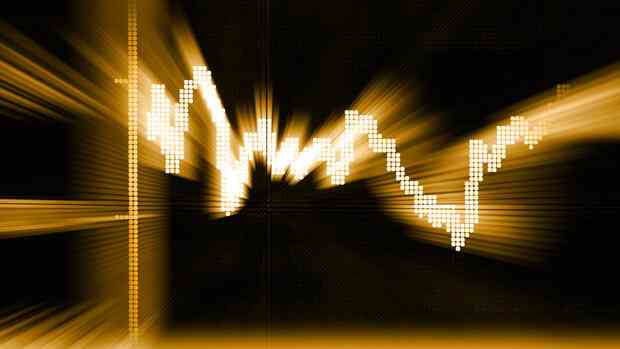Dusseldorf After three weak trading days, the German stock market is on the up again. After an interim plus of around one percent, the Dax was still 0.6 percent higher at 15,412 points at the end of trading. It is therefore not far to the annual high of 15,520 points, which would be equivalent to a continuation of the 3650-point rally since the end of September and should probably bring new impetus to trading.
Quotations on the bond market behaved differently. They gave way, and yields rose accordingly. A ten-year US Treasury bond now yields 3.65 percent, the low on Tuesday was 3.60 percent. The yield on a ten-year federal bond also rose to 2.36 percent from the previous 2.28 percent.
For the capital market expert Thomas Altmann, investors in the bond market are slowly beginning to believe that Powell will not immediately cut interest rates again this year. “However, we are still at the beginning of this pricing process,” he says.
The bond market reflects the interest rate expectations of market participants. Above all, the yields on two-year bonds are considered an important indicator of how the players assess the future interest rate level.
Some short sellers have closed their positions
If the Dax creates a new high for the year, it should be exciting. There may then be a short squeeze, a brilliant price jump like on Thursday last week, when the Dax shot up by around 150 points within a few minutes. Back then, many short sellers who had hedged against falling prices were caught on the wrong foot.
In the meantime, the starting position is no longer so clear. Short sellers have used the weaker trading days of the past few days to close some of their positions with presumably minor losses. That brought in losses, but less than in the previous week. At least that is what the Euwax sentiment of the Stuttgart Stock Exchange signals, which is calculated on the basis of real trades with leverage products on the leading German index.
At the end of last week, the proportion of put products in private investors’ portfolios was at its highest level since the Corona crash a good three years ago. The level has now dropped significantly.
Two areas are important on the bottom
Despite the possibility of Germany’s leading index continuing its rally with a new high, investors should not forget the downside. From a technical point of view, the area just above the 15,220 point mark offers short-term support. The lows of the past two trading days are around 15,275 points, and the rally continued on Thursday from 15,222 points, reaching a new high for the year. In addition, the high from last January at 15,270 points is close.
In the medium term, the area of 15,000 and 14,800 points is important, which was always hard fought in the previous two years. In the stock market year 2021, this area provided support for nine months. When the Dax fell below this mark in the course of the Russian invasion of Ukraine, it could not be overcome for eleven months. It was not until this January that the jump was made.
For Jörg Scherer, technical analyst at HSBC Germany, only a breach of this key zone would cause serious damage to German standard values. “With a hedge on this basis, investors secure part of the brilliant profits at the beginning of the year,” he explains.
Look at the individual values
Bayer: After sustained criticism from investors, Bayer boss Werner Baumann resigns prematurely. The Leverkusen-based pharmaceutical and agrochemical group announced on Wednesday shortly before the close of trading on the Frankfurt Stock Exchange that William Anderson, most recently head of the pharmaceuticals division of the Swiss group Roche, will become the new CEO as of June 1st. Bayer stock then went up by more than six percent.
Volkswagen: The automaker has boosted profits despite production disruptions due to missing chips and persistent supply shortages. However, the figures were within the expected ranges. The stock fell 1.4 percent. The VW numbers also burden the entire industry. The six biggest losers in the Dax 40 are all automotive stocks.
eon: The energy group scores with investors with a surprisingly higher result. Shares are up 1.8 percent. A trader said that Eon exceeded its own targets mainly because of an unexpectedly high result outside of its core business. “But the beat from non-core business doesn’t last, and a good result doesn’t really come as a surprise either.”
Qiagen: The diagnostics group was able to cushion the slump in corona products at the end of the year with a strong core business. Business outside of Corona increased by 15 percent. Sales of Covid products, on the other hand, collapsed by 61 percent due to significantly lower demand. This development gives the share a plus of about one percent.
ionos: The United Internet subsidiary made its debut on the Frankfurt Stock Exchange today, Wednesday. The shares of the web host and cloud provider started below their issue price of EUR 18.50 and were still at EUR 17.90 at the end of trading. Stockbrokers had hoped that Ionos could play the icebreaker that would end the long lull in the market for new issues, which only the sports car maker Porsche had interrupted last year.
Here you can go to the page with the Dax course, here you can find the current tops & flops in the Dax.
